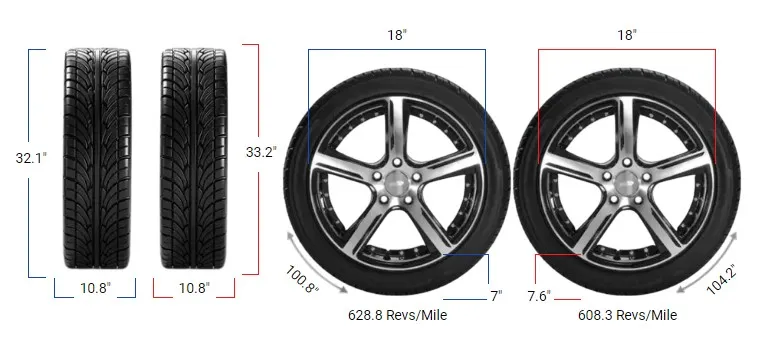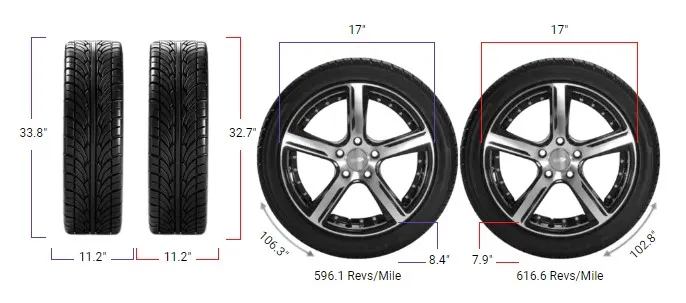Tire Size 215/45r17 vs 225/45r17

What if a tiny 10mm could transform your driving experience? That’s the allure of upgrading from 215/45r17 tires to 225/45r17 – a seemingly small change that promises big performance rewards. But is it really worth the switch?
- Improved lateral grip and cornering stability
- Increased straight-line traction for better acceleration and braking
- Slightly shorter dry braking distances
- Small reduction in fuel economy and acceleration
- Additional ground clearance for light off-roading

Fitment Guide
The new ones should be within 3% of the original tire’s overall diameter. In this case, the diameter difference between 215/45R17 and 225/45R17 is only 1.4%, well within the acceptable range.
This means that switching from 215/45R17 to 225/45R17 should not cause any major fitment issues.

On-Road Impact
How does this size change translate to real-world driving dynamics? The added width of 225/45r17 tires expands the contact patch, enabling:
- Improved lateral grip for enhanced cornering stability
- Increased straight-line traction, especially during acceleration and braking
- Slightly shorter stopping distances on dry pavement
The marginally taller overall diameter also causes the tires to rotate 1.4% slower. Without recalibrating the speedometer, it will read about 0.3 MPH slow at 20 MPH, 0.7 MPH slow at 50 MPH, and 1 MPH slow at 70 MPH. Fuel economy may see a small reduction as well, as the engine works slightly harder to spin the larger tires.
Ride quality is unlikely to change much, if at all. The sidewall height grows by less than 5mm, not enough to meaningfully impact compliance over bumps and broken pavement.
Road noise and vibration transmission may decrease a smidgen with the larger air volume, but don’t expect a major transformation in NVH.

Off-Road Impact
For light trucks and SUVs that venture off-pavement, upsizing to 225/45r17 rubber brings other advantages:
- Additional ground clearance, around 4.5mm, to better clear obstacles
- Wider footprint for improved flotation and traction on loose surfaces like gravel and sand
- Taller, more protective sidewall to resist damage from rocks and debris
The trade-off is a bit more unsprang weight, which can somewhat diminish ride suppleness when crawling over uneven terrain at low speeds.
The additional rotating mass may also slightly blunt acceleration from a stop. Still, the net off-road performance gain generally outweighs these minor drawbacks.
215/45r17 vs 225/45r17 Table
This table provides a quick overview of the size and performance changes when comparing the 215/45R17 and 225/45R17 tire sizes.
| Feature | 215/45R17 | 225/45R17 | Difference |
|---|---|---|---|
| Diameter inches (mm) | 24.62 (625.3) | 24.97 (634.3) | 0.35 (9) 1.4% |
| Width inches (mm) | 8.46 (215) | 8.86 (225) | 0.39 (10) 4.7% |
| Circumference inches (mm) | 77.34 (1964.44) | 78.45 (1992.71) | 1.11 (28.27) 1.4% |
| Sidewall Height inches (mm) | 3.81 (96.75) | 3.99 (101.25) | 0.18 (4.5) 4.7% |
| Revolutions per mile (km) | 819.24 (509.05) | 807.61 (501.83) | -11.62 (-7.22) -1.4% |
| Speedo Reading | 20 mph | 20.29 mph | +0.29 mph |
What is the Main Difference Between 215/45r17 and 225/45r17?
The main difference between 215/45r17 and 225/45r17 tires is that the 225/45r17 is 10mm wider than the 215/45r17.
Additionally, the 225/45r17 has a slightly larger overall diameter, which can impact handling, traction, and fuel efficiency, though the difference is small enough to be negligible in most cases.
Can I Use 225/45r17 Instead of 215/45r17?
Yes, you can use 225/45r17 instead of 215/45r17 because the overall diameter difference is only 1.4%, which is within the recommended 3% limit for tire size changes.
This small difference should not significantly affect your vehicle’s performance or safety, but it’s always wise to consult with a tire professional.
How Much Taller Is a 225/45r17 Tire Than a 215/45r17?
A 225/45r17 tire is about 0.35 inches (9mm) taller than a 215/45r17 tire. This slight increase in overall diameter may have minimal impact on your vehicle’s speedometer reading and ground clearance, but the difference is small enough that most drivers won’t notice a significant change.
How Much Wider is a 225/45r17 Tire Than a 215/45r17
The 225/45r17 tire is 0.39 inches (10mm) wider than the 215/45r17 tire. This difference in width translates to approximately a 4.7% increase, which can improve traction and cornering stability without drastically affecting fuel efficiency or ride comfort.
Our Observations
After analyzing the differences between 215/45R17 and 225/45R17 tires, we’ve found that the overall impact of switching is relatively minor for most drivers. The 10mm width increase and 1.4% diameter difference fall within acceptable ranges and shouldn’t cause fitment problems.
On the road, you may notice improved traction and handling, especially in wet weather. Ride comfort might slightly improve, while fuel efficiency could minimally decrease. Speedometer readings will be nearly spot-on.
For occasional off-road use, the wider tires provide a bit more traction and durability. However, these minor size differences aren’t a substitute for proper off-road tires if you frequently venture off the beaten path.
Ultimately, switching from 215/45R17 to 225/45R17 tires comes down to personal preference and priorities. If you value enhanced traction and handling, the wider tires may be worth considering. However, if you’re content with your current setup, the benefits may not justify the cost of upgrading for daily driving.



